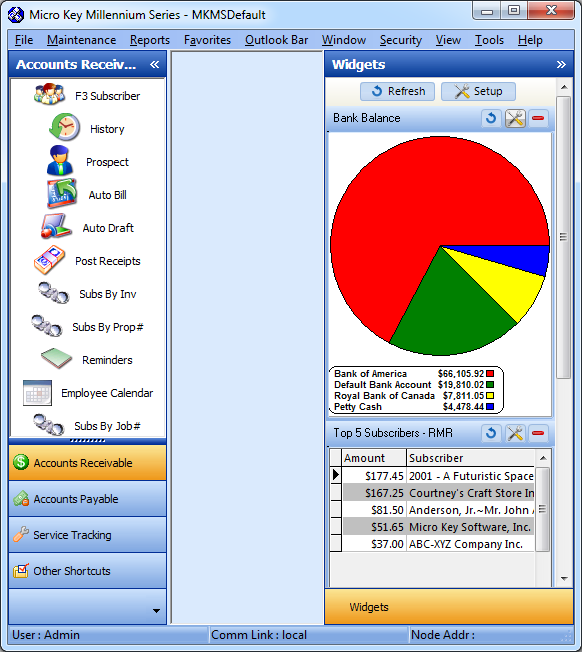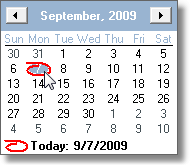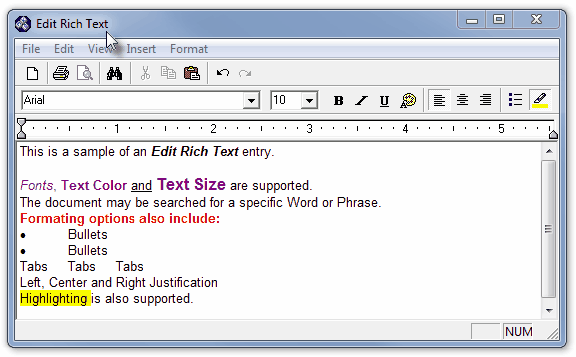| □ | Menus, Options, Special Functions, etc. are all component parts of the MKMS system's User Interface. |
| • | Menus - Menus are used to quickly navigate through the system and locate specific Forms to enter data, print reports and select options. |
| • | Function Keys - Certain Special Function Key combinations that allow instant access to specific Forms. |
| • | Data Entry Forms - These are the screen that allow you to enter all of the information used by the system. |
| • | Special Field types - Fields - the places within a Form where information is actually entered - come in many types such as numeric, general, specially formatted (telephone numbers, money, Drop-Down Selection Lists, special editors, etc.) and each type is documented as needed. |
| • | Settings - Presets allow you to define many default system behaviors, in advance. |
| □ | Menus - Once you've logged into the Micro Key Millennium Series ("MKMS"), (see Getting Started) you're ready to start. |
| • | MKMS uses a standard Windows® application (top of form) Drop-Down Menu structure - referred to as the Main Menu - with the main choices displayed horizontally across the top . |
| • | Each of these Main Menu choices have Drop-Down Menus that allow you easy access to each feature available within the MKMS program. |
| • | As with most other Windows® applications, the standard Windows Keyboard Shortcut methodology is accessible by holding the Alternate key down while pressing the menu selection's underlined letter to open that choice without having to Click on the desired option with your mouse. |
| • | This Alternate Key + Letter feature is also available when Forms have Sub-Tabs with a Title that has an underlined letter. |
| • | There is also an Outlook® Bar styled vertical menu on the left side of the main program screen (the MKMS Desktop). |
| • | We call this the Main Shortcut Bar. |
| ◆ | These Main Shortcut Bar choices are also available using the Outlook Bar selection on the Main Menu . |

Main Menu of the Micro Key Millennium Series
| • | The Outlook® Bar styled Main Shortcut Bar menu may be modified or completely hidden. |
| • | Right-Click on it and Choose whether you want Large or Small Icons, or if you want to hide this menu altogether choose Hide Main Shortcut Bar. |
| ▪ | To unhide the menu, on the Main Menu at the top of the MKMS Desktop, Select View and Check Main Shortcut Bar. |
| • | The Main Shortcut Bar may be collapsed (temporarily hidden) by Clicking the double left arrow << to provide more space for Forms |
| ▪ | It can then redisplayed by Clicking the double right arrow >> to make a menu selection. |
| • | Not all Menu Selections defined in these Help Files will be available to every User. |
| • | Certain Modules must be registered before their Module Specific Menu Options are displayed. |
| □ | Other Main Menu options: |
| • | Window - Provides standard Windows® application choices for how the various active Forms will be presented on the MKMS application's Desktop. |
| • | Tools - The Main Menu's Tools option allows you to define selections that access utilities you may often use, such as the Windows® Calculator and Notepad applications. |
Specialized Functionality
| □ | Many Forms have their own menus and also offer special features accessed with Icons illustrating their purpose. |

MKMS Main Menu Systems showing Subscribers Form with its Quick Access Menu, Widgets, and the Comments tab selected
| ► | In the example above we see: |
| • | The MKMS Desktop showing the Main Menu across the top and the Outlook® Bar styled menu down the left side. |
| • | This Outlook® Bar styled Main Shortcut Bar menu may be temporarily collapsed when more space is needed on the MKMS Desktop. |
| • | Click the Double Left Arrows << to close the menu, and Click the Double Right Arrows >> to open it again. |
| • | The Word Merge Icon automates the letter writing process |
| • | Reports allows quick access to commonly used reports |
| • | Scale allows you to re-set the size of the Form to your preference |
| • | Filters allows you to specify a Subscriber Filter which define what (selected group of) Subscribers may be viewed |
| • | Label allows for the instant creation of an Address Label for the current Subscriber. |
| • | An Outlook® Bar styled Quick Access Menu Shortcut Bar specific to the currently opened Form. |
| • | In the example above, the Subscribers Form has Receivable, General, Service and Job Costing menu bars - each of which provide selections specific to managing that phase of your Subscribers information or easily access routine business processes. |
| □ | Drop-Down Selection Lists |
| • | There are often cases where the allowable entry in a field must be selected from a predefined list. |
| • | These predefined lists may be included with the system, or they may have been user defined (such items might include a list of Employees, Sales Categories, Vendors, etc.). |
| • | These special data entry fields - Drop-Down Selection Lists - have all the available choices which typically were previously User defined as part of a module's Maintenance Entries process. |
| • | They appear as a Mandatory Entry Field when displayed with a Yellow background, or as a regular (optional) entry field when displayed with a normal White background. |

Mandatory Drop-Down Selection List field
| • | In either case, by Clicking the Down Arrow q button on the right of the field, a list of all acceptable (usually user-defined) entries will be displayed. |
| • | Type the first letter or two of your desired selection and, as you type, your typed entry will be used to locate the item closest to it. |
| • | If you do not know what you are looking for and all of the choices are not shown, Click and Drag the Slide Bar to the right of Drop-Down Selection List to view the entire list of options. |

Drop-Down Selection List
| • | To make the appropriate selection, Click on it. |
| • | Additionally, a Drop-Down Date Selection Box are used to select (Click on) a specific date. |
| • | Click the red circle at the bottom right of the Drop-Down Date Selection Box to select Today. |
| • | Click the left arrow to move back one month, or the right arrow to move forward one month. |
| • | Click the Month (in the illustration below, the word September itself) and you will get a Drop-Down Selection Box with all months listed. |
| • | Click the Year (in the illustration below, the number 2009 itself) and you will get a Drop-Down Selection Box with a long list of Years from which to choose. |

A Drop-Down Date Selection Box
| • | Comment fields usually support the Rich Text Editor interface that allows bold, italics and underlines of text, and the selection of Font type, it's size, color, and highlight. |
| • | Double-Click the field to see if the Edit Rich Text box appears. |

Edit Rich Text Form
| • | Finally, all of this data entry must have a purpose. And it does. |
| • | Whether it's billing recurring revenue in hours rather than days; getting your bills paid quickly, easily and on time; properly managing your service department and tracking your inventory, costs, profits and revenue easily and consistently, it's knowing that you finally have control of your business operations that makes this effort worthwhile. |
| • | So in the end, Reports and special Processes help you run your business in the best, most efficient and professional manner possible. |
| • | The User Settings functionality "remembers" each User's specific usage selections. |
| • | Individual User Settings remember certain Form locations (any change in size settings), most recently selected Report Options, any Drop-Down (field to search by) Selection List, and most recently entered search character entries. |
| • | All these options are stored on a per User login name, therefore the User Settings are unique from User to User. |
| • | If operating on a Network, and have Users who move from station to station on occasion, User Settings follow those Users around the network, regardless of what workstation the User has logged on to. |
| □ | More Features - The following chapters contain important additional information on how other useful MKMS features are used: |
| 1. | Information Processing Forms - Forms consist of the program's background area, current Form's title, data entry fields, and any other information presented by the MKMS for the function or process you requested. |
| 2. | Tabbed Forms - Some Forms may have tabs which provide space for additional information about the master subject. These tabs are used to provide additional space for information about the master Form's subject. |
| 4. | Printing to a File - Some Reports must be saved as they looked Today. Generally this is because the report is a "snap shot" report of Today's current status and would be different "tomorrow". |
| • | These "snap shot" reports should be "printed" to a file - preferably a "pdf" file - so that it can be viewed at any time in the future but with the information as it existed on the exact day the report was originally run. |
| 5. | Advanced Search Dialog - The Advanced Search Dialog provides the User a method to locate and Select a specific record that is contained within a table in the MKMSDefault (and any other Multi-Company) database. |
| 6. | Rich Text Editor - Allows you to enter bold, italicized and underlined text, and the individual selection of Font type, it's size, color, and to highlight areas of text. |
| 7. | Tools Menu Setup - Allows you to establish personal menu selections for frequently used external application. |
| 8. | Styles - Each Style changes the way the MKMS desktop is displayed - both in the color combination, icon and display style. |
| 10. | Re-Order Table View Header - You may Re-Order Header Names, and therefore the data in those columns, in the Table View on most Maintenance related Forms. |
| □ | Special Company Settings allow you to customize the behavior of certain features within MKMS. |
| • | These Special Company Settings create rules on a Company wide basis. |
| • | By doing so, you will define important information for MKMS that will be used by everyone accessing the module(s) you are responsible for setting up. |








